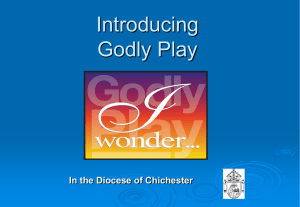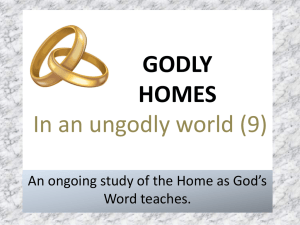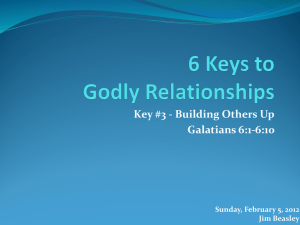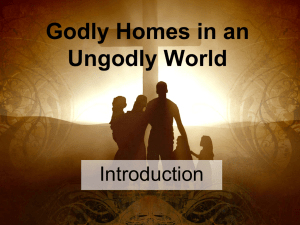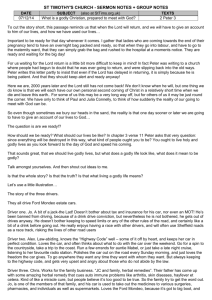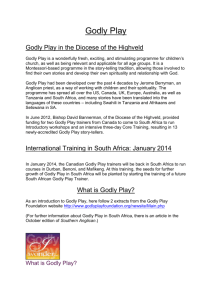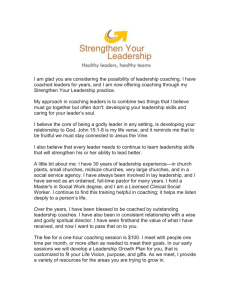GODLY PLAY - RE conference 2009 - Hertfordshire Grid for Learning
advertisement
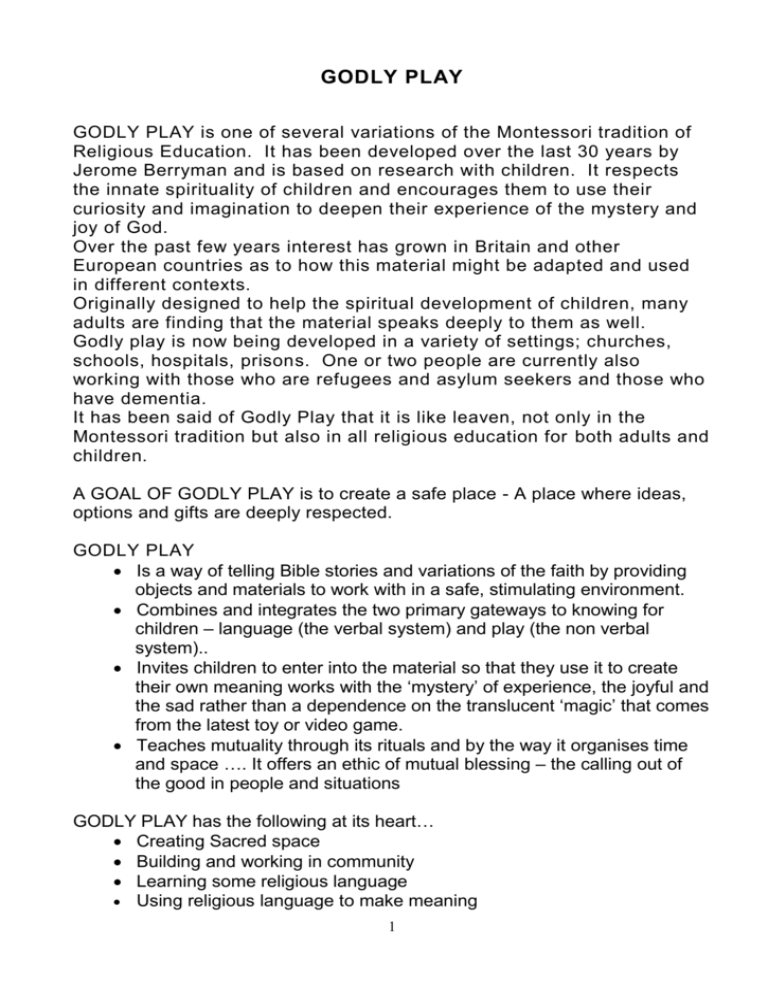
GODLY PLAY GODLY PLAY is one of several variations of the Montessori tradition of Religious Education. It has been developed over the last 30 years by Jerome Berryman and is based on research with children. It respects the innate spirituality of children and encourages them to use their curiosity and imagination to deepen their experience of the mystery and joy of God. Over the past few years interest has grown in Britain and other European countries as to how this material might be adapted and used in different contexts. Originally designed to help the spiritual development of children, many adults are finding that the material speaks deeply to them as well. Godly play is now being developed in a variety of settings; churches, schools, hospitals, prisons. One or two people are currently also working with those who are refugees and asylum seekers and those who have dementia. It has been said of Godly Play that it is like leaven, not only in the Montessori tradition but also in all religious education for both adults and children. A GOAL OF GODLY PLAY is to create a safe place - A place where ideas, options and gifts are deeply respected. GODLY PLAY Is a way of telling Bible stories and variations of the faith by providing objects and materials to work with in a safe, stimulating environment. Combines and integrates the two primary gateways to knowing for children – language (the verbal system) and play (the non verbal system).. Invites children to enter into the material so that they use it to create their own meaning works with the ‘mystery’ of experience, the joyful and the sad rather than a dependence on the translucent ‘magic’ that comes from the latest toy or video game. Teaches mutuality through its rituals and by the way it organises time and space …. It offers an ethic of mutual blessing – the calling out of the good in people and situations GODLY PLAY has the following at its heart… Creating Sacred space Building and working in community Learning some religious language Using religious language to make meaning 1 GODLY PLAY SPACE A Godly play room contains shelves full of objects for people to use. Objects that make the images of religious language come alive. Ideally it is customary to sit in a circle on the floor – literally surrounded by the religious language system. (but in other settings this may not be possible) The materials used to help tell the story of the day can then be placed in the centre of the circle, symbolising that God can be present and accessible to everyone – both students and teacher. Working in a circle helps to emphasise many aspects of being in community. WONDERING QUESTIONS Are the key to help reflection on the story. Depending on the type of the story, a different format of questions is asked. Each response is treated with utmost respect … a formula is often used … ‘Yes it could be that … it could be all these things’ The questions are kept deliberately open ended. You can find details of the questions under the different genre of Godly Play. RESPONSE Each person then chooses to respond to the story in whatever medium they choose. A range of art materials, writing materials, books, and puzzles is offered as well as the opportunity to retell/ play with the stories using the objects and materials Teacher directed crafts are not part of the session; participants take responsibility for the activity. Everyone will be wrestling with the different issues and some may want to stay with the story for more than one week. It may be that people wish to sit quietly and apparently do nothing. GODLY PLAY Helps people of all ages to explore some key questions that we all face from the moment we are born; what does it mean to be alone/ in community? What does it mean to have freedom/ lack of freedom? What happens when we are faced with death? What meaning can we make from our life/ experience? 2 Doing Godly Play A typical session of Godly Play lasts around 45 minutes to one hour, although sessions can last longer if sufficient time is available. Two adults, a story-teller and a doorperson should be present to facilitate the session, which typically proceeds through the following stages: At the threshold - the children are welcomed by the doorperson and invited to sit in a circle with the story-teller. Building the circle - the story-teller settles the group in preparation for the story (Berryman, following the Montessori tradition, uses the term 'lesson'). Presenting the lesson - the story-teller focuses on the special materials used to present the story. These are usually three dimensional figures crafted in natural materials. Wondering - the children are invited to wonder about the story and explore their connectedness to it. Some wonder aloud; others in silence. Response - the children decide on their own response to the story, which may be through art work, or learning to retell the story with the original materials, or through games, maps, puzzles or books. The feast - the work is put away, everyone returns to the circle and the feast is shared (the feast is something to eat and drink). Saying goodbye - the session ends and each child is spoken to, by the storyteller and by the doorperson, before they leave. 3 Principles behind Godly Play Christian Education is ‘teaching the art of theological cognition by means of religious language’. Children need to ‘wonder’ to enter the religious language They need to work together in an environment that encourages respect and love and teachers must shape that They need to choose their own work so that they can return again and again to images that work for them to help them cope with their existential limits and ultimate concerns The art of using religious language needs to be learned in an environment filled with the whole system of religious language for sensorimotor learning so that lessons presented can be set beside the whole system that fosters creative coping with ultimate concerns Religious Language needs to be learned in an environment that supports the connecting of religious language, the creative process and the experience of the creator The time of religious education needs to be shaped by the classical structure of the Holy Eucharist to provide the most tested approach to God, the creator 4 THE DIFFERENT GENRE IN GODLY PLAY SACRED STORIES. Sacred stories are told to stimulate a sense of Christian UNITY At the same time they provide raw materials for the development of a coherent sense of Christian IDENTITY. These stories are told to invite the children to become, themselves, part of the story. One of the themes is that based on the child's game of HIDE AND SEEK. The people of God are called into a relationship that proves to be both revelatory and elusive. Sacred Story Questions These invite participants to become part of the story I wonder what part of this story you like the best? I wonder what part of this story you think is the most important? I wonder if you are in this story and that the story is in you? I wonder if there is any part of this story that you would like to leave out... and still have all the story you need? PARABLES Parables stimulate our sense of CREATIVITY They also QUESTION our everyday view of life. They wake us to SEE NEW POSSIBILITIES They offer ALTERNATIVES TO THE STATUS QUO, the orders imposed by power, class or tradition. Parable Questions Generally move through the following sequence I wonder if this character etc has name? I wonder what it is like to be here? I wonder what this might really be? When different parts have been wondered about... I wonder where this whole place might really be? LITURGICAL ACTIONS Liturgical actions stimulate a sense of INTEGRATION of identity and creativity (given through Sacred Stories and Parables) We mark LIFE, TIME and SPACE to evoke a sense of CONNECTION. Liturgical Action Questions The same as Sacred Story with additions such as I wonder if you have come close to this? I wonder where this might be when it's not there? I wonder if you have seen something like this? Depending on the material - I wonder if you have touched-smelled-heard etc something like this? Godly Play Genre May 2003 PJP taken from Volume 1 The complete Guide to Godly Play and other materials by Jerome Berryman 5 A Godly Play Room 6 The Heart of Godly Play Creating sacred Space Learning the Religious Language How we tell stories How we are with the children Have we made the story our own? How we dialogue Do we convey a love of the stories How we support silence Building and Working in Community Using religious language to make meaning How we are with the children How we support the wondering How we dialogue How we support silence How we support silence How we support the response time How we support the circle of children 7 GODLY PLAY CONTACTS `Sit quietly while you feel the story forming within, you. Then say...' 'The preparation of the storyteller is of primary importance. Godly Play resources are available from the St Albans Diocesan Resources Centre, Holywell Hill, St Albans , the London Diocesan Resources Centre and other Diocesan resource centres around the country. The storyteller must personally own and sense the greatness, mystery and awe of God in the story.' Visit the U.K. Godly Play website www.godlyplay.org.uk for information re training events at the Godly Play classroom near Cambridge and other places, information re materials for teaching and to link to the network of people interested in Godly Play. But silence serves another function. It gives space for the Holy Spirit to act in the imagination.' `in biblical stories, tell only the actions and descriptions essential to the story... when you speak do so with an economy of words.' Also www.godlyplay.org the website for the Centre for Theology of Childhood based at Christ Church Cathedral Houston Texas. `W ondering questions come out of the depth of your experience in the story... This activity is the foundation on which theological thinking is built.' Godly Play Materials: contact St Michaels Cottage Crafts Bowthorpe Community Trust Bowthorpe Hall Road Norwich NR5 9AA Telephone 0.1603 746106 email bowthorpecommtrust@lineone.net Ask for the Compute Guide to Godly Play catalogue Also Godly Play Resources 122 W. 8'`' Street. PO Box 563, Ashland, Kansas 67E'31, USA email www.godlyplay.com ` Art responses enable the children to express understandings and work through critical issues they cannot or do not wish to express verbally.' ' These stories of God, speak to their fears, of being abandoned, lost or alone, of pain, suffering and even death. W hen they learn to enter the stories and meet God, they have a tool for living and discovering meaning in any place at any time.' (Quotes from: Jerome Berryman) A number of people are available to give advice/support information can be found on the UK website or contact; BOOKLIST Revd John Fellows 40 Churchfield, Harpenden, Herts 01582 764738 cft cfellows@tiscali.co.uk The London Diocesan resources Centre Godly Play An Imaginative Approach to Religious Education: Jerome W . Berryman Pub: Augsburg (Theory/Philosophy of Godly Play) ISBN 0-8066-2785-9 Godly Play has also been piloted in schools through the National Society. For more details visit their website. Teaching Godly Play; The Sunday Morning Handbook: Jerome W . Berryman: Abingdon Press Nashville (Implications for practice)ISBN 0-687-08651-5 Thanks to Peter Privett who produced part of this handout. He can be contacted at 28 Oakfield Road Rugby CV22 6AU. Three day training courses for pe ople who want to become accredited Godly Play teachers are run by Peter Privett and Rebecca Nye at the Godly Play centre in Cambridge and other places around the country. Details at www.godlyplay.org.uk The Complete Guide to Godly Play (published Autum n 2002 Living the Good News) - 6 volumes. Vol 1 gives the theology and an introduction to Godly Play. Vols. 2;3,4 give scripts for lessons. Volume 5 outlines ways o f adapting Godly Play to different settings Volume 6 was published in 2006 Other authors are using the Godly Play method of wondering questions. For example Lucy Moore in ‘The Lord’s Prayer unplugged’ published by BRF 8
